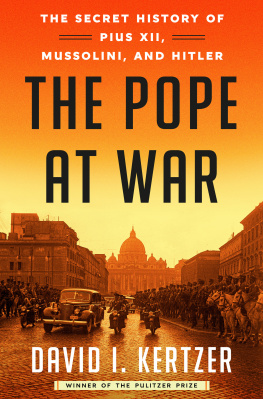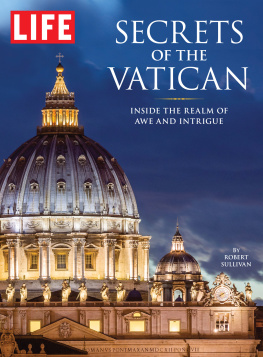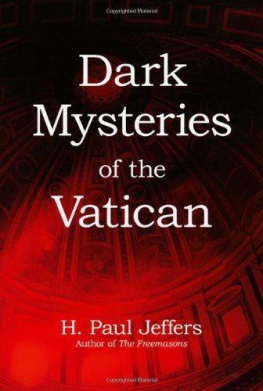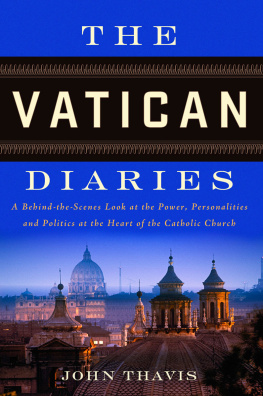
H. Paul Jeffers
Dark Mysteries of the Vatican
Copyright 2010 H. Paul Jeffers
To Jennifer and Mark Nisbit
For there is nothing hid, which shall not be made manifest: neither was it made secret, but that it may come abroad.
Jesus Christ (Matthew 4:22)
Introduction: Keys to the Kingdom
Almost from the moment Jesus Christ changed the fisherman Simons name to Peter and gave him the keys to the kingdom of Heaven, the religion that was built in Christs name began keeping secrets out of necessity. Deemed by the Roman emperors to be dangerous, Christians literally went underground by gathering to worship in catacombs and caves. They came up with secret hand signals, symbols, and other signs of recognition and means of communication to avoid detection and persecution. From its outset, Christianity was a religion of secrets.
After three centuries of suppression, the outlaw status of followers of Christ ended when the Emperor Constantine converted to the religion after literally seeing the light. While on the way to battle his most powerful rival, Maxentius, at the Tiber River in A.D. 312, he reported seeing the cross of Christ superimposed on the sun with the words In hoc signo vinces (In this sign you shall conquer). He ordered his men to put crosses on their shields and won the battle. The very next year, he met with Emperor Licinius, ruler of the Roman Empires eastern provinces, to sign the Edict of Milan, giving equal rights to all religious groups within the Roman Empire. He returned property seized from Christians, built a large number of churches, donated land, sent his mother to Jerusalem to find the place where Christ was crucified and build a church on the spot, and ordered the bishops of the religion to convene in the first Council of Nicaea in A.D. 325 to deal with false teaching within the church. Results of this conclave were a formal list of Christian beliefs (the Nicaean Creed) and approval of texts for inclusion in the Holy Bible.
In this process of canonization, by which excluded texts were deemed to be heretical, the bishops who met at Nicaea claimed an absolute authority to decide what knowledge could be disseminated and what should be kept secret that the Roman Catholic Church continues to assert. When Constantine constructed the Basilica of St. Peter on Vatican Hill in the heart of Rome as the throne of Peters successors, it became the Holy See.
The current location of St. Peters Basilica is the site of the Circus of Nero in the first century. After Constantine officially recognized Christianity, he started construction (in 324) of a great basilica on the spot where tradition placed the crucifixion and burial of St. Peter. In the mid-fifteenth century, it was decided to rebuild the old basilica. Pope Nicholas V asked architect Bernardo Rossellino to start adding to the old church. Construction on the present building began under Pope Julius II in 1596 and was finished in 1615 under Pope Paul V. Surrounding structures that constitute Vatican City include buildings that house the Vatican Secret Archives.
As defender of the faith for more than sixteen centuries and the repository of the suppressed knowledge of centuries, the Vatican has become the focus of people who weave countless legends, myths, and tales of mysterious doings, sinister secrets, and dark criminal conspiracies concocted within its walls. Contributing to suspicions surrounding the Vatican is an aura of mystery that has surrounded the Roman Catholic Church for centuries, including use of Latin in ceremonies, secrecy in the selection of popes, symbolic robes and headpieces, rituals of worship, belief in miracles and apparitions of saints, and the Churchs historic claim that in matters of faith the pope was infallible. All this left non-Catholics feeling that the Church was rooted in secrecy.
Nothing has been more fascinating to those who believe that the Vatican hides things than the Vatican Secrect Archives. From the years immediately after the crucifixion of Jesus, popes carefully preserved manuscripts in the scrinium Sanctae Romanae Ecclesiae. Today the files of 264 popes and the Vatican hierarchy fill thirty miles of shelves of documents tied with red ribbon (the origin of the term red tape). Housed in Renaissance buildings not far from the Sistine Chapel in Vatican City in the heart of Rome, there are files on not only the entire history of Christianity but on Western civilization. No one, including the pope, can state with certainty how many secrets and scandals lie in the archives. The oldest document dates back to the end of the 7th century, while the archives have an almost uninterrupted documentation starting from 1198. The Secret Vatican Archives are primarily used by the Pope and his Curia, that is [the] Holy See. In 1881, under Pope Leo XIII, the Archives were opened to be freely consulted by scholars, thus becoming the most important center of historical research in the world.
Some material has been made available on the Internet. More than six hundred archival sources extending over more than fifty-two miles of shelves, covering over eight hundred years of history, can now be visited on the Vatican website (www.vatican.va).
The oldest document dates back to the 7th century, while uninterrupted documentation is maintained from the year 1198 onward It i possible to see Michelangelo Buonarottis letter to the Bishop of Cesena (January 1550), the minutes of the trial of Galileo (1616-33), letters about Henry VIII and his desire to annul his marriage to Catherine of Aragon so he could wed Anne Boleyn, and the parchment in which Pope Clement V granted absolution to the leaders of the Knights Templar (August 17-20, 1308), after they were burned at the stake.
Widespread belief that the Vatican archives are crammed with dark secrets arose in 2003 with the publication of Dan Browns novel The Da Vinci Code and later with the movie based on it. The fictional story presented an elaborate centuries-old plot by the Church dating to the years when the Knights Templar conspired with the Church to suppress proof that Jesus was married to Mary Magdalene, that they had a daughter, that the child was the holy grail, that she was taken to France, and that her descendants, the bloodline of Christ, are walking around the world today. Although the facts contained in the novel have been subsequently exposed as false or misleading, the effect of the novel and movie has been to strengthen the belief that the Vatican will go to any length to keep its secrets from being revealed.
While The Da Vinci Code presented an imaginary conspiracy, the history of the Vatican is replete with actual events that the Holy See was eager to keep secret and with incidents that outsiders were just as eager to whip up into fantastic theories involving murder, poisoned popes, illicit sex, conniving with Nazis, Communist conspiracies, stolen gold and art treasures, and other nastiness in which the truth was suppressed.
Arranged chronologically and thematically, this book explores this fascinating saga of the dark secrets of the Vatican to sift fact from fable and illuminate the truth of what lies in the archives, from sexual escapades of popes and priests, murders in holy orders, financial scandal, and international intrigue to stories of UFOs, and prophecies about the end of the world.
Thou Shalt Not Read
When movie director Ron Howard requested permission in 2008 to shoot scenes for Angels & Demons, the latest movie thriller by Dan Brown, that takes place in the Vatican and Rome s churches, Archbishop Velasio De Paolis, head of the Vatican s Prefecture for Economic Affairs, banned use of any Church property in Rome. He said that the author of The Da Vinci Code had turned the gospels upside down to poison the faith.
Next page






